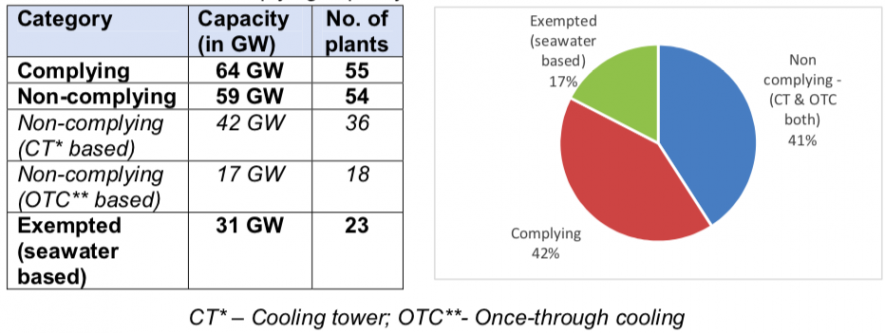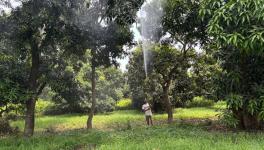CSE Survey Says Coal Plants Flouting Water Norms with Impunity
India’s coal based power plants – an ever expanding industry with the most water intensive usage in the country – have been found flouting major water consumption norms. The violation is leading to scarcity and conflict as glaring loopholes over self-monitoring systems and further dilutions of other norms, such as the fly ash pollution guidelines, loom large.
In its extensive survey on coal-based power plants the Center for Science and Environment highlighted that six years since water consumption norms came into force, the water-guzzling coal-power industry is ignoring regulations; it added there was a high degree of non-compliance observed in the sector. The report surveyed over 154 GW of total coal power capacity and found about 50% of the freshwater-based plants were non-compliant. Most of these plants belong to state-owned companies. The largest number of non-complying plants were from Maharashtra and Uttar Pradesh. Working under MahaGENCO (Maharashtra State Power Generation Company) and the UPRVUNL (Uttar Pradesh Rajya Vidyut Utpadan Nigam), a majority of these plants are old, with inefficient practices which lead to water wastage.
The companies constitute about 75% of the total installed coal power capacity in India. Almost half the plants did not comply with the specific water consumption norms of 3.5/3 m3 per MWh. Total non-complying capacity stood at 59 GW and complying capacity was 64 GW.
Nivit Kumar Yadav, programme director at the CSE's Industrial Pollution Unit, said, “This is when many power producing regions of the country are facing acute water shortage. Also, there is huge water pollution due to the effluent discharge by power plants.”

Source – CSE
The report stated that the coal-power industries were among the most water-intensive in India, responsible for about 70% of the total freshwater withdrawal by all industries in India. About 48% of the existing coal-power fleet is located in water-scarce regions. Coal-power plants in water-scarce regions such as Nagpur and Chandrapur in Maharashtra; Raichur in Karnataka; Korba in Chhattisgarh; Barmer and Baran in Rajasthan; already face the brunt of water scarcity.
According to the 2015 norms, which were revised again in 2018, plants installed before January 1, 2017 were to meet the specific water consumption limit of 3.5 cubic metres of water per MWh; plants installed after the said date had to meet the norm of three cubic metres of water per MWh, apart from adopting zero liquid discharge.
All plants were required to meet the norms within two years of the notification, i.e. by December 2017. The norms were, however, largely ignored. As the deadline to meet the norms ended on December 7, 2017, the Central Pollution Control Board (CPCB) wrote to all power plants stating, among other things, "the new timeline for compliance of water consumption limit shall be finalized in consultation with the plants". Since then, no individual timelines have come up for the plants to follow.
Sugandha Arora, the author of the report, told Newsclick there had been no significant improvement state-wise "due to the absence of any effective deterrence system put in place by the union environment ministry, especially in case of meeting water consumption norms. These norms have been completely overlooked. Since the time (2015) the norms came into place for coal power plants which included both emission and water norms, we have only seen its dilution and the extension of deadlines. Though the ministry recently – in April 2021 – came up with an amendment which gave new timelines to the coal power sector for meeting emission norms, it was silent on water norms and there was no emphasis put on it,” she added.
Experts say a major issue with the policy has been the loopholes in the self-reported data and data formats being followed across states to report specific water consumption. Many plants continue to underreport or report their specific water consumption incorrectly to authorities in the environment statements. There is no third party monitoring and verification done of the self-reported data through annual water audits.
Moreover, the upcoming draft on fly ash pollution is also likely to aid flouting of these norms, Arora said, adding: “The previous fly ash notification made it mandatory for all power plants to utilise 100% of its ash in dry form. If all power plants try to utilise their generated ash in dry form to the maximum extent possible, then the issue of ash slurry disposal and ash pond overflows can be drastically reduced."
"However the latest draft notification in circulation, if notified, considerably dilutes and relaxes the previous fly ash regulations in place and will only lead to more fly ash breach incidents and more water consumption in ash disposal due to absence of any effective deterrence system in place in the draft notification," she said.
The report has suggested that the environment ministry and regulatory authorities must prioritise implementation of norms in water scarce regions and making cross-verification and monitoring of self-reported water consumption data by third party agency through annual water audits mandatory.
Get the latest reports & analysis with people's perspective on Protests, movements & deep analytical videos, discussions of the current affairs in your Telegram app. Subscribe to NewsClick's Telegram channel & get Real-Time updates on stories, as they get published on our website.
























